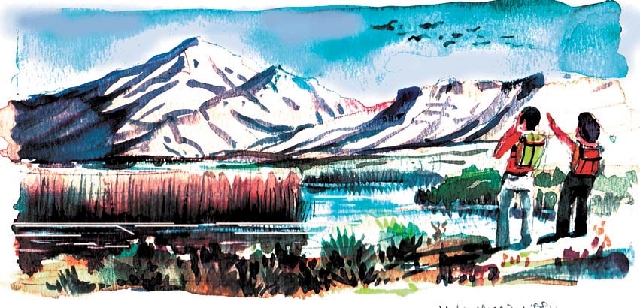Wetlands Park shows importance of water in desert

This spring, new facilities open for visitors to the 2,900-acre Clark County Wetlands Park on the eastern edge of the Las Vegas Valley.
In coming weeks, a new cafe will open adjacent to a visitor center with museum-style displays and exhibits about the park. Now open, a 210-acre Nature Preserve is part of the first phase of developing the area as a county park. In a handsome complex of buildings completed last fall, an information desk manned by staff and volunteers provides maps and brochures detailing features in place and plans for the future.
To reach the park, follow Tropicana Avenue east from Boulder Highway to Wetlands Park Lane and then follow signs into the Nature Preserve parking lot, which has spaces for cars and buses, lighting, restrooms, a shaded picnic area and walkways to the information center, museum and auditorium complex, all environmentally friendly.
The park is open dawn to dusk daily free of charge. The information desk is manned from 9 a.m. to 3 p.m. For details or for group arrangements, call 702-455-7522.
Work continues on various projects throughout the area. Visitors may notice several imaginative metal sculptures and water features that were recently placed around the complex. One of the charming new metal statues with water features stands near an elevated viewpoint next to the visitor center complex overlooking part of the wetlands park. Water dripping from oversized white flowers fills green leaf cups that tip and dump the water into a creek below, and a couple of small waterfalls create background music.
A system of paved and gravel foot trails explores the Nature Preserve at the west end of the large wetlands area. The trails take visitors on mostly level pathways or boardwalks along waterways, through marshy vegetation and trees and near open ponds that attract a wide variety of resident and migrating waterfowl. The trails within the Nature Preserve are intended for walking and are accessible for disabled visitors. No motorized vehicles, skateboards, rollerblades, bikes or dogs are allowed. Bikers, dog walkers and horseback riders must use trails or roads outside the Nature Preserve.
As you approach the park, note signs for the Duck Creek Trail, which can be reached from Broadbent Avenue. This half-mile trail links with two other paths that may be used by dog walkers and bicyclists. Major trail heads, such as the one for Duck Creek Trail, have paved parking areas, restrooms, solar lighting and picnic areas. Existing roads into the wetlands are open for equestrian use. Planned horse trails will be graded soil pathways 12 feet wide with protective berms.
The Wetlands Park is a long-term solution to a long-standing problem. The area lies in the lowest part of the Las Vegas Valley, the natural channel for surface water to follow as it heads for the Colorado River Basin and Lake Mead, the source of the valley’s drinking water. Wetlands developing along the outflow serve as a natural filter for polluted runoff and treated waste water.
The need for management of the area became critical years ago when floodwater erosion channeled the water so that it rushed through the wash into the lake. As the wetlands dried up and died out, fires in the dead marshes became commonplace. These blazes focused attention on the Las Vegas Wash. Many government entities, organizations and concerned individuals worked cooperatively for several years to produce a management plan for the area. The Clark County Wetlands Park is a major part of that plan.
Visitors to the park observe the plan in action and see why it is working. As they explore the huge oasis created by the runoff from the Las Vegas Valley, visitors discover the richness of life in a desert when water is present and its destructive power reined in.
Nature has been helped by small dams, or weirs, and native plants and trees are thriving. The water attracts nearly 300 kinds of birds. Raccoons, beaver and certain types of fish have made their way up from the river. Insects breeding in the marshes feed fish, birds and 18 species of bats. Predators such as coyotes, foxes, bobcats, hawks and eagles find plenty of prey.
Visit the wetlands soon. The arrival of spring will make the experience even more rewarding.
Margo Bartlett Pesek’s column appears on Sundays.